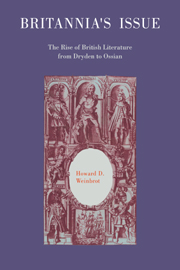Book contents
- Frontmatter
- Contents
- Acknowledgments and editorial notes
- INTRODUCTION: An overview of scope and method
- PART I CONTEXTS: INTELLECTUAL, PSYCHOLOGICAL, AND NATIONAL
- PART II TEXTS WITHIN CONTEXTS. ESSAYING ENGLAND: OUR GENIUS, OUR CLIME
- PART III GROWING ONE'S OWN. THE BRITISH ODE FROM COWLEY TO GRAY
- PART IV EXPANDING THE BORDERS. JEWS AND JESUS: THIS ISRAEL, THIS ENGLAND
- PART V CELTS, GERMANS, AND SCOTS: TOWARDS A UNITED KINGDOM
- Prologue to Part V
- 13 CELTIC SCOTLAND
- 14 OSSIAN IN SCOTLAND, GREAT BRITAIN, AND MODERN EUROPE: JOINING BRITANNIA'S ISSUE
- 15 CONCLUSION. SYNTHESIZING ALL THE NATIONS UNDER HEAVEN
- APPENDIX: The text of Handel's “Israel in Egypt”
- Index
14 - OSSIAN IN SCOTLAND, GREAT BRITAIN, AND MODERN EUROPE: JOINING BRITANNIA'S ISSUE
Published online by Cambridge University Press: 15 December 2009
- Frontmatter
- Contents
- Acknowledgments and editorial notes
- INTRODUCTION: An overview of scope and method
- PART I CONTEXTS: INTELLECTUAL, PSYCHOLOGICAL, AND NATIONAL
- PART II TEXTS WITHIN CONTEXTS. ESSAYING ENGLAND: OUR GENIUS, OUR CLIME
- PART III GROWING ONE'S OWN. THE BRITISH ODE FROM COWLEY TO GRAY
- PART IV EXPANDING THE BORDERS. JEWS AND JESUS: THIS ISRAEL, THIS ENGLAND
- PART V CELTS, GERMANS, AND SCOTS: TOWARDS A UNITED KINGDOM
- Prologue to Part V
- 13 CELTIC SCOTLAND
- 14 OSSIAN IN SCOTLAND, GREAT BRITAIN, AND MODERN EUROPE: JOINING BRITANNIA'S ISSUE
- 15 CONCLUSION. SYNTHESIZING ALL THE NATIONS UNDER HEAVEN
- APPENDIX: The text of Handel's “Israel in Egypt”
- Index
Summary
In 1776 Ewen Cameron impugns Johnson for having maliciously rekindled a properly dying flame. Hugh Blair's discourse of 1763 “silenced for a Time the Enemies of Ossian; till Dr. Johnson's Journey to the Western Islands of Scotland coming out last Year, renewed the Dispute, and set again all the Scribblers in an Uproar.” Cameron knows that such illiberal hacks merely seek to mask an ugly attack on Scotland. Cameron borrows his counter-smear from Macpherson's own earlier Introduction to the History of Great Britain (1771): “it must appear very ridiculous in a Descendant of the Saxons, a Branch of the savage Sarmatae, to stigmatize with that Appellation [of barbarous] the undoubted Remains” of the once great and far-ranging Celtae.
Cameron is among the many Scots who regarded Ossian as the genuine work of a genuine master. Hume at first so believes, and Smollett soon calls Ossian Britain's “best and most antient poet whom tradition hath handed down to posterity.” In 1763 another Scot tells Edinburgh that now “Northern tribes” surpass Greece, a Highland hill replaces Parnassus, and “That Ossian was himself the True Apollo.” Hugo Arnot puts the matter bluntly in 1779: “To reject the authenticity of the poems of Ossian, we apprehend impossible.”
Others of varied nationalities hardly cared whether Ossian was fact or fiction, since whoever invented him was the real thing. In 1762 Gotthold Lessing condescends to the Journal encyclopédique's notion that Fingal is valuable only if ancient – so much the worse for the French, he says.
- Type
- Chapter
- Information
- Britannia's IssueThe Rise of British Literature from Dryden to Ossian, pp. 526 - 556Publisher: Cambridge University PressPrint publication year: 1993
- 1
- Cited by



